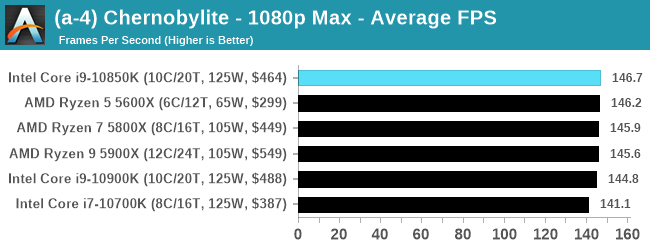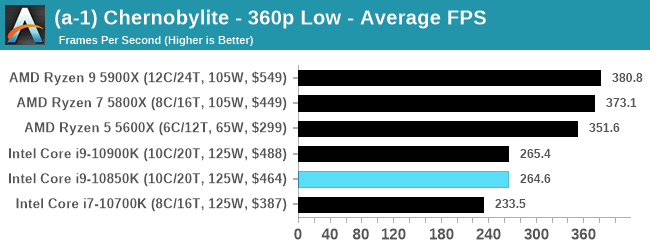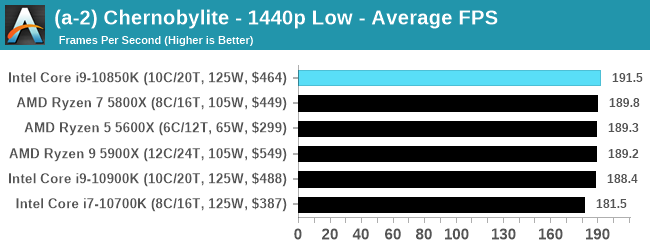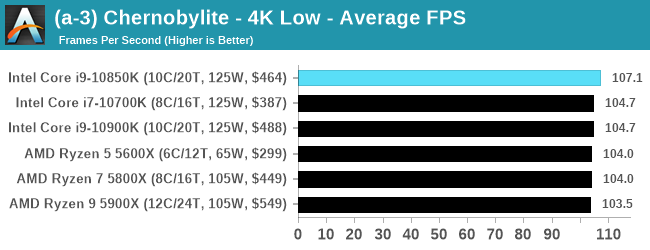Intel Core i9-10850K Review: The Real Intel Flagship
by Dr. Ian Cutress on January 4, 2021 9:00 AM EST- Posted in
- CPUs
- Intel
- Core
- Z490
- 10th Gen Core
- Comet Lake
- LGA1200
- i9-10850K
Gaming Tests: Chernobylite
Despite the advent of recent TV shows like Chernobyl, recreating the situation revolving around the 1986 Chernobyl nuclear disaster, the concept of nuclear fallout and the town of Pripyat have been popular settings for a number of games – mostly first person shooters. Chernobylite is an indie title that plays on a science-fiction survival horror experience and uses a 3D-scanned recreation of the real Chernobyl Exclusion Zone. It involves challenging combat, a mix of free exploration with crafting and non-linear story telling. While still in early access, it is already picking up plenty of awards.
I picked up Chernobylite while still in early access, and was impressed by its in-game benchmark, showcasing complex building structure with plenty of trees and structures where aliasing becomes important. The in-game benchmark is an on-rails experience through the scenery, covering both indoor and outdoor scenes – it ends up being very CPU limited in the way it is designed. We have taken an offline version of Chernobylite to use in our tests, and we are testing the following settings combinations:
- 360p Low, 1440p Low, 4K Low, 1080p Max
We do as many runs within 10 minutes per resolution/setting combination, and then take averages.

| AnandTech | Low Resolution Low Quality |
Medium Resolution Low Quality |
High Resolution Low Quality |
Medium Resolution Max Quality |
| Average FPS |  |
 |
 |
 |
All of our benchmark results can also be found in our benchmark engine, Bench.











126 Comments
View All Comments
edzieba - Monday, January 4, 2021 - link
I dunno, sounds like an opportunity for ambient-pressure water phase-change cooling to me! Who needs evacuated heat-pipes or vapour-chambers when you can just spray the top of the IHS directly!shabby - Monday, January 4, 2021 - link
Hey Ian can you put the real cpu wattage in the charts that the cpu used in that test rather than the fake one? We all know this cpu never uses 125 watts.Drkrieger01 - Monday, January 4, 2021 - link
You either skipped the 'Power Consumption' page, or don't understand CPU TDP ratings. The '125W' rating is the 'non-turbo' rating, meaning power consumed at max non-turbo clock rate. AMD does the same thing, and also has a higher power consumption during turbo (although not anywhere near as much as Intel does).shabby - Monday, January 4, 2021 - link
Since each benchmark varies it would be nice seeing how much wattage each cpu used during that benchmark.Yes i know amd uses more power during turbo, the 5950x uses 30 watts more than advertised... compared to ~140 watts more that intel advertises their 10850k to use. That quite the difference don't you think?
Drkrieger01 - Monday, January 4, 2021 - link
Unless you're working on a power budget, I honestly wouldn't worry about it. Most review websites don't have the time/man-power to trace the power usage on each benchmark for each CPU. You will also have a variance between processors of the exact same model due to binning/silicon lottery. You're better off planning to use/dissipate the full turbo power of the CPU than hope for lower power. Or just buy an AMD (if you can find one!)eek2121 - Monday, January 4, 2021 - link
Actually AMD chips use the TDP value as the maximum power value minus the IO power, so all AMD chips use a total of 143 watts at maximim.Flunk - Monday, January 4, 2021 - link
Intel seems to have six similar i9 SKUs with prices ranging from $453 to $488. Seems rather pointless. Maybe Intel marketing should spend some time thinking about whether or not their insanely complex model scheme is contributing to their lack of sales. AMD has ONE SKU that competes with all of those Intel SKUs. Clock down for lower TDP doesn't need to be an entire SKU.Duwelon - Monday, January 4, 2021 - link
Whoever comes up with Intel's SKUs must be the same person/people responsible for interfacing with USB Implementers Forum on Intel's behalf. The industry is replete with remarkably confusing naming schemes, seemingly on purpose.DanNeely - Monday, January 4, 2021 - link
Making the low power versions use the same model number would be a very anti-consumer move because you'd have no easy way to know if you were getting the 3.7Ghz or 1.9Ghz model. We already have that problem on mobile where two laptops with identical specs perform wildly different because one is running the CPU at 2x the power/performance of the other. Using separate model numbers also lets you bin chips that perform best at low and high power levels separately.The production limit bins (10850K and both IGPless KF models) muddle things up a bit; but Intel's desktop lines are very cleanly broken out vs what they did a decade+ ago with a mess of different similar chips with varying cache sizes and clock speeds but the same core counts; or the ongoing mess of their mobile line (good luck figuring anything out about one of those chips from its model number without looking it up).
Crazyeyeskillah - Monday, January 4, 2021 - link
they have various skus for oem's, system builders, general public, retail products, ect ectCertain OEMs require a non-open market skus to promote their products or run at certain specs that differentiate them from what's available on the open market.